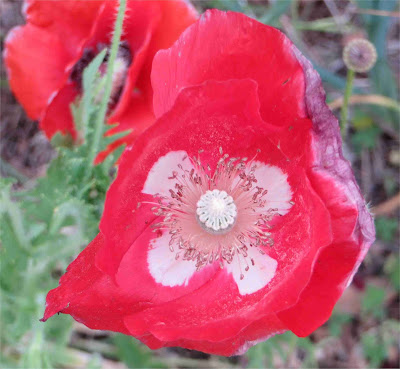I'll bet that most gardeners, if they have any concept of winter-blooming garden irises at all, would think of the late winter blooming reticulate irises. Those who have checked out the genus iris a bit more thoroughly might be aware of some of the winter blooming scorpiris (Juno) species such as Iris rosenbachiana. But by and large these are specialists' plants which require careful management if they are to persist from year to year.
But as more and more of us in the greater Washington, D.C. area are discovering, there is another winter-blooming iris which, if carefully sited, deserves consideration as a reliable garden plant. That iris is Iris unguicularis in its several forms.
Looking back over the last ten or twenty years in this garden, I think one of the greatest sources of pleasure has been the discovery that yes, we can grow and flower Iris unguicularis in our climate. Forty or so years ago when I first attempted this plant the results were not good: although the plant itself survived from year to year, it never produced flowers. It did produce buds, but they always froze before opening.
I don't think there is another species of iris which has a longer period of bloom: the plants here bloom from early November into early April. The flowers generally come one or two at a time, although when conditions are just right the clumps might be ringed with bloom. And the individual blooms are substantial: they remind me a lot of the blooms of the late June blooming Iris brevicaulis (foliosa). I've included an image of Iris brevicaulis for comparison.
Three forms of this winter iris are grown here. Two are typical large forms, one is the small form often listed as Iris cretensis. The two large ones came without labels from the local gardens of friends. In a sense, there is also a fourth form here, the plant known as Iris lazica. This one typically begins to bloom later than the others.
In the images above, you see first the two large forms, then the small, narrow leaved Iris cretensis, and then for comparison Iris lazica and Iris brevicaulis. Iris unguicularis, I. cretica and I. lazica are native to various sites in the Mediterranean region from northwestern Africa to the Black Sea. Some of the Greek forms show intense color combined with vivid patterning. Iris brevicaulis is presumably not at all closely related to these as irises go: it's native to the south central United States.
The images of Iris unguicularis and I. cretica were taken today; the images of I. lazica and I. brevicaulis are from previous years.
I've seen these winter-blooming irises growing well and blooming freely in several local, northern Virginia gardens. Here in my garden the Iris cretensis and one of the Iris unguicularis are in cold frames; one of the Iris unguicularis grows in the open right against a sunny wall. And they all get covered in bitter weather. That's a small price to pay to have such big, colorful flowers in the garden during the winter.


























































